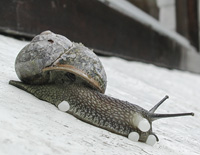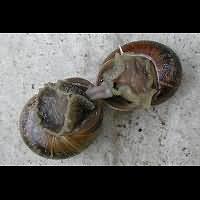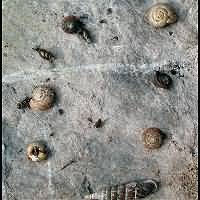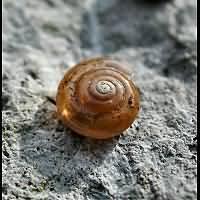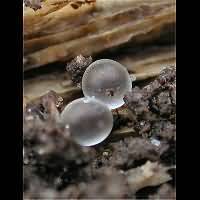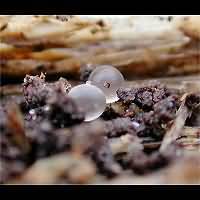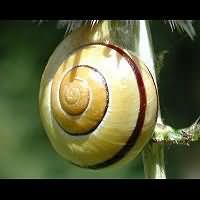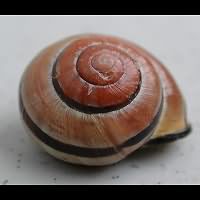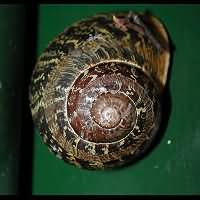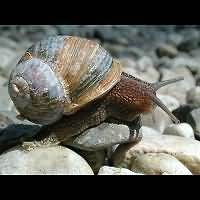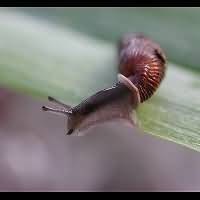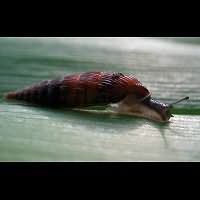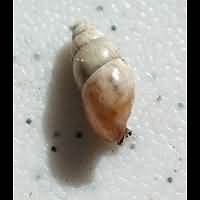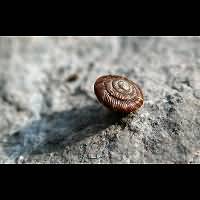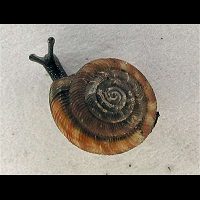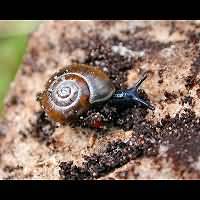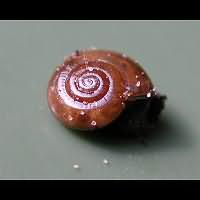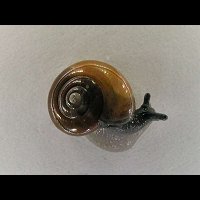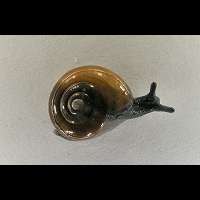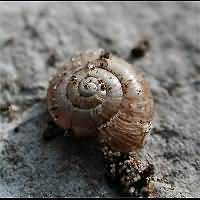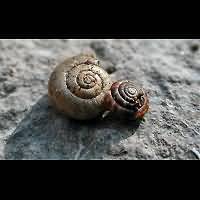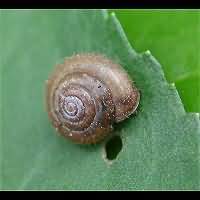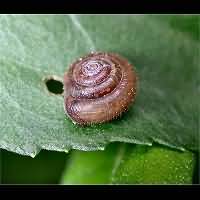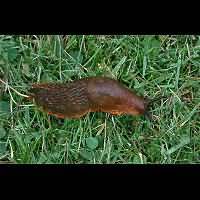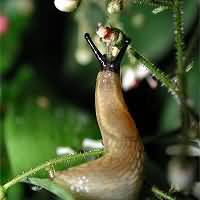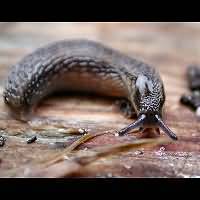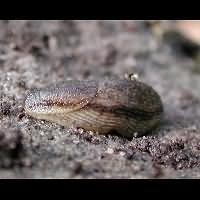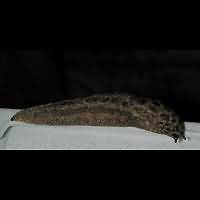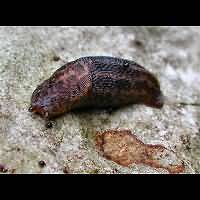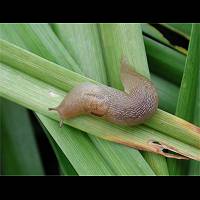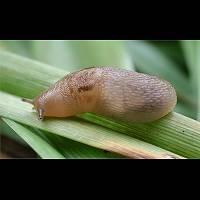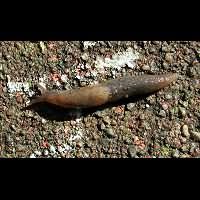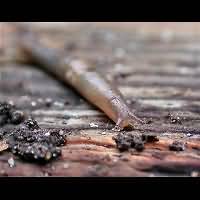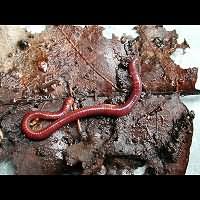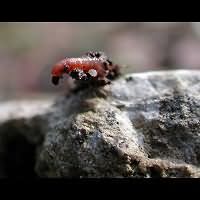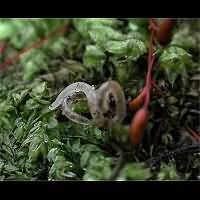[All pictures of garden wildlife on this page are thumbnails. Click on any thumbnail for a large format to be displayed.]
Snails, Slugs and Worms
Contents: 1 molluscs, 2 worms.
![]()
The majority of molluscs live in water and most of them live in the seas. A number of them has adapted to living on the land and the best known of them are the slugs and snails. Both groups occur in our garden and some birds eat them. I have an impression that the slugs are less often consumed by birds. The Song Thrush simply loves snails. He uses stones and a paved path in the garden where he crushes the shells of the snails. Slugs and snails can be a pest in your garden. They have a very special feauture: they are hermaphrodites, which means that they are male and female at the same time! So when mating you will see two male organs and all snails and slugs lay eggs!
On the left: It really does look like the eggs are coming out of the ear... On the right: Snails are hermaphrodites ![]()
In most gardens there are many more snails and slugs than you might think. Many species are small, very small and overlooked by most of us. Just turn around some stones or old wood and in most cases you'll find some snails attached. The snails in the picture to the left below have been collected in a few minutes time. They are all less than one centimeter in length, so you really have to look carefully! Below you'll find these species dealt with individually.
Various very small snails collected in our garden in just a few minutes.
The eggs of snails and slugs can be found in all gardens, especially in moist places. They do look like small crystal balls. Actually they can be used to foretell the future: one day small snails or slugs will crawl out of them!
These eggs are probably a slug's.
Content: 1.1 snails, 1.2 slugs.
Below you see the best known snails: the Garden Snail. But did you know there are actually two species? The only way to tell them apart is by looking at their lipp (the opening of the shell). In one species the lipp has a light band and therefore the animal is called the White-lipped Snail. In the other species this band is brownish or black. This species is thus called... the Brown-lipped Snail. Both species can have exactly the same colours and both come in yellow, pink, brown and all shades of these colours. Their shells are identical as well, so only the colour of the lip gives them away.
On the left: a yellow White-lipped Snail (Cepaea hortensis) and on the right a pink Brown-lipped Snail (Cepaea nemoralis).
The Brown Garden Snail is edible. It is sold as escargot, the name used for many edible snails. The Brown Garden Snail is the second best choice for gourmet use. The number one snail for kitchen use is the Roman Snail, which has a lighter colour and is slightly bigger than the Brown Garden Snail. The Roman Snail usually lives in warmer climates than the Brown Garden Snail, which is not choosy at all. The species has been taken by men on his journeys and can now be found all over the world. It turned out to be a pest especially in Australia and California. The Roman Snail can live up to 30 years (at least in captivity). The shell of the species to the right resembles that of a Roman Snail, but according to Jan Hein Visser it actually is just a worn out shell of the Brown Garden Snail.
More appreciated in the kitchen than in the garden: the Brown Garden Snail (Helix aspersa).
The next snail remained undiscovered in our garden for a long time. It is a very beautiful creature whose shell resemble shells that can be found by the ocean. The rascal is small though. The entire shell hardly reaches two centimeters en the animal itself is about 0.7 centimeters. It obviously belongs to the family of Door Snails and is called the Common Door Snail or Thames Door Snail (Balea biplicata).
This snail is the Common Door Snail (Balea biplicata).
Below you see a shell that even doesn't make half a centimeter. Ik belongs to one of the many snails that all look alike and live in moss. It will not come as a suprise to you that they are called Moss Snails.
This is the Glossy Pillar (Cochlicopa lubrica), a moss snail.
The shell below is extremely small, but very beautiful and colourful as well. It is named after its shape: Round Snail. This species lives almost world wide. In Northern America it is often called the Rotund Disc.
This little snail is known as the Round Snail or Rotund Disc (Discus rotundatus).
Another little snail we haven't yet been able to identify. It looks like the Cellar Snail very much, except for the colour, which is brown and not amber. There are many species of small snails like that and it is not easy to make a good identification. It is quite certain though that both are Oxychilus species. The on to your left has been identified by Tom Meijer being the Dark-bodied Glass Snail (also known as Draparnaud's Glass Snail. The other one has to de with an Oxychilus sp. for the time being. In case you know the exact name, please send us an email: info@gardensafari.net. Thanks to Tom Meijer, Hanny Reneman and Christabel Ashby for their help.
Two small snails of the glass snails group. To the left the Dark-bodied Glass Snail (Oxychilus draparnaudi), to the right an Oxychilus sp.
The Cellar Snails or Glass Snails are notoriously difficult to identify. At times the one below presents us with less difficulties, for it is a smelly creature. It smells like garlic and that explains the name: it doesn't live on garlic, it just smells like it. The identification however is tentative.
This could be the Garlic Snail, also known as Garlic Glass Snail (Oxychilus alliarius).
The shell below looks like an ordinary garden snail, bot it is much smaller (just slightly bigger than the previous species' shell) with a nice, ivory colour. Reaching a diameter of some 8 mm it is larger than the Round Snail. In the picture to your right both species for comparison. It is called the Clear Glass Snail and it is a nephew of the glass snails above.
This beautiful, but empty shell once belonged to a Clear Glass Snail (Aegopinella nitidula).
The snail below is a very strange thing indeed. It is hairy! Who would ever think about such a thing: a hairy shell. It is small, like the Oxychilus and seems to be less abundant in our garden. It is the Hairy Snail.
This strange creature is the Hairy Snail (Trichia hispida).
Slugs carry no shell. The most common slug, the Large Red Slug, comes in as many colours as the Garden Snails do. It is sometimes red or orange, but can be white, yellow, brown or black as well. You can easily recognize the Large Red Slug thanks to the rim between the body and the foot. The rim is red-orange independent of the colour of the rest of the body. This rule only applies to the adults. The juveniles however lack the orange rim, but may have a beautiful black head instead. They slug may grow to be some 15 centimeters long!
One of the biggest and most dreaded slugs: the Large Red Slug (Arion rufus). To the left an adult, to the right a juvenile.
The other very common species is the Black Field Slug. It too comes in many colours, but it lacks the orange rim near the foot and it has a dark stripe at the side of the body. In the USA The Black Field Slug is called the Garden Arion, while the Large Red Slug is referred to as Orange-banded Arion. Both species can be a pest in the garden and we suppose no American celebrates the day of their introduction into the New Land. The Black Field Slug has recently been split up into three species: the Black Field Slug (Arion hortensis), the Warty Arion (Arion owenii) and the Garden Slug (Arion distinctus). These species are very similar indeed and can only be told apart for sure by anatomical analysis. It is quite probable though the species below is the Garden Slug.
The Garden Slug (Arion distinctus) used to be called the Black Field Slug.
Nearly all snails and slugs are a pest in the garden. They all eat dead plants, but most chew on living leaves as well. They favour big, juicy leaves, such as the ones found on cabbage. The largest snail in the Benelux is the Great Grey Slug. The animal is also known as the Giant Garden Slug, and, because of the spots, Leopard Slug. It can be 20 centimeters long and live for up to three years. It is a strange slug indeed, for it feeds on leaves, but also on carrion and even hunts for other slugs! It is a nocturnal animal.
This is the Great Slug (Limax maximus), that even hunts for other slugs.
Even though it is not absolutely certain this is Lehmania valentiana, experts think it most likely is. This is a southern species which used to be very rare in the Benelux. But nowadays it regularly pops up in gardens and parks. It is a relative of the Great Slug, but rather indistinct and pale. This species seems to conquer the world quickly: it has already been found in Eastern Europe (Poland, Lithuania), Russia, Northern America (Missouri), Central America (The Dominican Republic) and even South America (Colombia). It has already reached the British Isles as well.
A very invase species conquering the world: Lehmania valentiana.
To have or not to have a shell, that's the question... Having a shell means that you are a snail, not having one means you're a slug. Millions of years ago slugs had shells too. They lost them in the cause of evolution, but still have a remainder: chalky grains or even een chalky plate just behind the head. You can easily see the spot in the pictures below. They are of the biggest pest of all snails and slugs in the garden: the Grey Garden Slug. It will eat almost any plant and can be extremely destructive in rainy summers.
We think this is the Netted Slug, also known as the Grey Field Slug or Grey Garden Slug (Deroceras reticulatum).
The world is full of worms and most of them do not live in gardens but in the seas or on the coast. In Holland there are some 50 species of worms that all live underground. There is only one species that pops up onto the surface regularly and that is the well-known Earth Worm. This reddish animal is extremely important as the best recycler Mother Nature has invented. It eats all kinds of dead plants and the droppings it produces are rich pure humus which is so important for vegetation in our gardens.
The Earth Worm (Lumbricus terrestris) plays a key part in many ecosystems.
Below a small white worm. Actually we had no idea what we were talking about. Luckily Rob Baerselman made a good suggestion. According to him this is a relative of the Earth Worm, belonging to a group called... Whiteworms. The creatures are white, thinner and much smaller, reaching some 2 centimeters in length only. It is used in tracing pollution, for in contrast to its cousins the earthworms, which are very tolerant, they stand an extremely limited amount of pollution only. And that by itself is good news for us, because we see the creature in our garden regularly. During rainy days it can be found above the earth, especially in mosses.
This probably is a Whiteworm (Enchytreaus albidus), one of the Earth Worm's cousins.


© Copyright 1998-2024 gardensafari.net (Hania Berdys)

 English / engels
English / engels  Dutch / nederlands
Dutch / nederlands